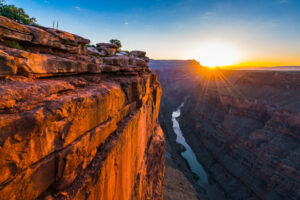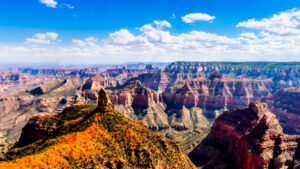
The day unfolds with the rhythmic hum of wheels on asphalt as our rented passenger van cruises through northern Arizona toward the Grand Canyon.
The landscape transforms gradually as we descend from the alpine serenity of Coconino National Forest into a patchwork of golden desert landscapes scattered red with dust and sprawling plateaus. Dried sage brush emerges from dusty, rocky roadside terrain. Native Americans sell jewelry and rugs at roadside booths as the open road draws us closer to one of nature’s most majestic wonders.
I’ve flown in from Baltimore, along with my wife and our two children. We’ve met up with my parents and brother for this epitome of family road trips. The drive from Flagstaff to the Grand Canyon’s East Entrance (to the South Rim) is about an hour and a half.
The magnificence of the surrounding desert land and distant mountains serve as a prelude to the natural beauty we’re about to see.
Grand Entrance
A palpable excitement fills the air as we pass through the gates of Grand Canyon National Park.

The initial view is awe-inspiring, but it isn’t until we’re out of the car, standing at the rim, that we can really take in the array of colors radiating beneath the sun—a painted rainbow in rock.
The Colorado River, etching its course through the canyon’s heart, adds a silver ribbon below. This is a journey into the depths of the Grand Canyon. We linger to allow the time this moment deserves.
All Along the Watchtower
The Desert View Watchtower is positioned right on the canyon’s edge. The building echoes the simplicity of ancient Puebloan towers, blending seamlessly with the natural surroundings.
Ascending the tower, each level offers a fresh perspective of the canyon. The observation deck at the top treats us to a 360-degree view. The interior is filled with murals and cultural art of the indigenous tribes in this region.
We cruise about 10 miles of park road, stopping along the way for new and exciting views of the canyon. Eventually, we land at the Grand Canyon Visitor Center, where the elevation is about 4,300 feet above sea level.
Moving On Up

An emerald-striped park service shuttle weaves us through South Rim Village, past quaint log cabins and bustling cafes. The air thins, crisp and exhilarating, as the shuttle switches back and forth along the narrow road.
At the end of the line, we get off at the highest stop: Mather Point. Here, standing at the edge of the canyon, the world itself feels transformed. The elevation is 7,009 feet.
A Lesson of the Land
The canyon’s formation began nearly 6 million years ago as the Colorado River cut through the rock layers, revealing a cross-section of Earth’s crust. The canyon exposes rock formations dating back to nearly 2 billion years.
This area’s significance to indigenous people dates back thousands of years, with tribes like the Hualapai, Havasupai and Hopi considering the canyon sacred.
President Theodore Roosevelt designated it a national monument in 1908. Subsequent efforts by conservationists led to the establishment of Grand Canyon National Park in 1919.
The park has since become a UNESCO World Heritage Site, drawing millions of visitors each year.
Going North
It would be hard to see both sides of the canyon in a day, but we have a few, so we decide to go north. The drive from the south entrance around the canyon to the north is about twice as long as our drive from Flagstaff.

We come nearer to the North Rim and drive through grasslands filled with grazing bison. Prairie dogs pop in and out of their holes. For half an hour, it feels like we’re in an altogether different climate. But the closer we come to the edge, the more obvious it is that this, too, is Grand Canyon country.
New Perspectives
Our exploration of the North Rim begins at Point Imperial, this side’s highest overlook. Standing here, we’re treated to an awe-inspiring panorama of the canyon below.
This side of the canyon, although less traveled, is ripe with picturesque sights: Angel’s Window, a arch sculpted by the forces of wind and time; Bright Angel Point, the North Rim’s iconic lookout; Tranquility Point, true to its name. There’s a pointed peak known as Vishnu Temple and a rock formation called Zoroaster Temple. With the Colorado River sparkling below, the scenery is unrivaled.
We end our time on the North Rim back at Imperial Point for a sunset view. The setting sun paints the canyon in a riot of crimson and gold.
Eric D. Goodman is author of seven books and more than 100 published short stories and travel stories. His latest, Faraway Tables, is a book of travel-centric poetry. Learn more about Eric’s travels and writing at www.EricDGoodman.com.




